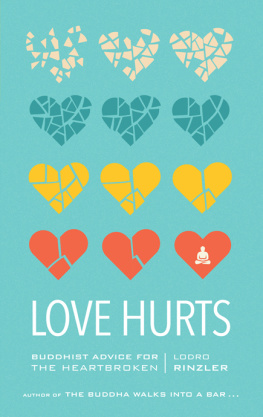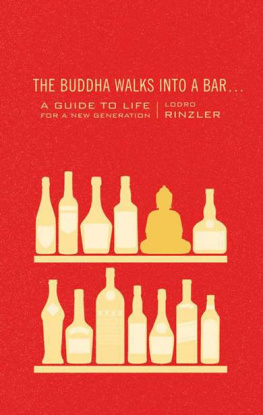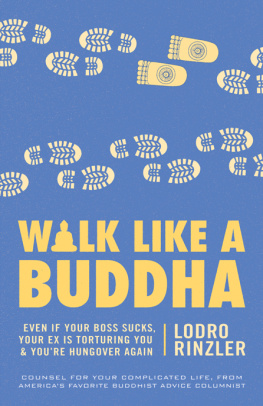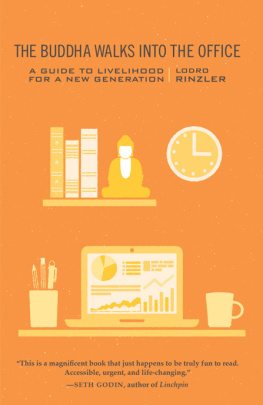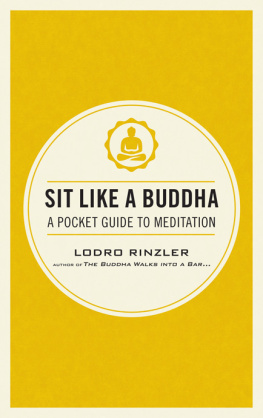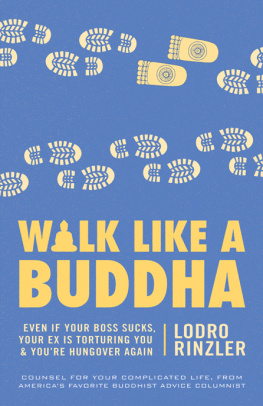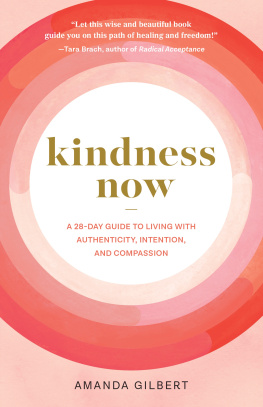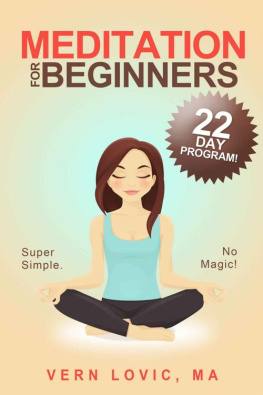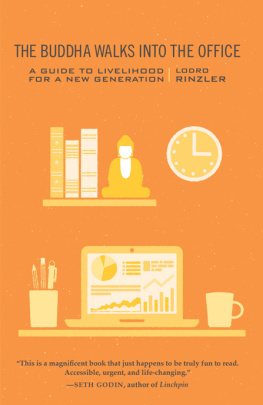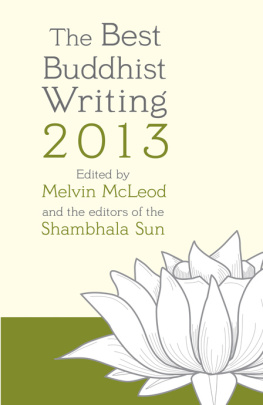ABOUT THE BOOK
Believe what youve heard about meditation: itll focus your mind, open your heart, and sometimes surprise you with insight. And its not complicated to learn. In fact, everything you need to get started is contained in the pages of this little book. Lodro Rinzler begins by challenging you to ask yourself why you want to meditate in the first place (good newstheres no wrong answer!). With your intention thus in place, he teaches you all the basics, along with advice for making your meditation practice a priority no matter how busy you are. He then shows you how to bring the wisdom and compassion you discover in meditation into all other areas of your life.
LODRO RINZLER is a teacher in the Shambhala tradition of Vajrayana Buddhism. He has taught numerous workshops and retreats. His column What Would Sid Do? (Sid = Siddhartha, the Buddha) appears regularly in the Huffington Post.
Sign up to receive news and special offers from Shambhala Publications.

Or visit us online to sign up at shambhala.com/eshambhala.
SIT LIKE A BUDDHA
A POCKET GUIDE TO MEDITATION

Lodro Rinzler

Shambhala
Boston & London
2014
Shambhala Publications, Inc.
Horticultural Hall
300 Massachusetts Avenue
Boston, Massachusetts 02115
www.shambhala.com
Cover art: Shutterstock/banderlog
Cover design by Daniel Urban-Brown
2014 by Paul Rinzler
All rights reserved. No part of this book may be reproduced in any form or by any means, electronic or mechanical, including photocopying, recording, or by any information storage and retrieval system, without permission in writing from the publisher.
Library of Congress Cataloging-in-Publication Data
Rinzler, Lodro, author.
Sit like a Buddha: a pocket guide to meditation/Lodro Rinzler.
First edition.
pages cm
eISBN 978-0-8348-3005-9
ISBN 978-1-61180-165-1 (alk. paper)
1. MeditationBuddhism. I. Title.
BQ5612.R58 2014
294.34435dc23
2014004049
For Milo, who is small. May this be of benefit when you are bigger.
CONTENTS
I was raised Buddhist. I started practicing Buddhism at an early age. I began teaching it at the age of eighteen. But it is not Buddhism that has made me who I am. It is meditation. Meditation practice has calmed me when I felt anxious, softened me when I put up walls around my open heart, and allowed me to be more present in both the pleasurable and painful aspects of my life. I owe whatever contentment I have found in this life to meditation practice. That being said, I am honored to offer you this book, which will help you get a meditation practice going.
When I was eighteen years old I enrolled as a freshman at Wesleyan University and quickly began looking for a community to meditate with. I put posters up everywhere and a good number of people showed up for that first meeting. The only issue? None of them knew how to meditate. There werent a lot of available resources for meditation practice on my college campus; when I discussed this issue with a mentor he pointed out that I had attended a number of retreats that were prerequisites for a meditation instructors training. Why dont you do it? he said. A few months later I was trained up and stumbling through offering meditation to others for the first time.
I would like to think that in the dozen-plus years I have been offering meditation instruction I have gotten better at it. Even if the words I say when I offer instruction have not shifted dramatically my understanding of them may have. Particularly when my first book, The Buddha Walks into a Bar, came out I found myself traveling a great deal and offering meditation to new practitioners in across North America. Meeting with thousands of individuals in the last few years has softened me, and allowed me to refine what it is we talk about when we talk about meditation.
I have never sat down and attempted to write a full book solely about meditation practice. Even though Ive verbally presented these teachings before, I worry that the experience of meditation and how it has affected my life may lose its meaning in translation to these pages. I hope this volume is helpful, that it does aid you in establishing a meditation practice. If not (and even if it does) let me know. Getting a meditation practice going is a long journey, and Im here to support you however I can. Im easily found by e-mail, on Facebook, and on Twitter, and I post meditation videos regularly on YouTube.
Ive had a firmly established meditation practice for a while and it has changed me in the most miraculous ways. It continues to allow me to be more present and compassionate as time goes on. If you follow along with this book, I believe you will establish a meditation practice, too, and will see the results of this transformative experience. This is a bit of an experiment, as this read does rely on your actually doing the practice introduced in these pages. Give meditation a chance and join me in this experiment, okay? To reiterate: Im here for you; well do it together.
Lodro Rinzler
June 6, 2013
Brooklyn, New York
Whenever someone tells me that they are interested in meditating I always ask them why. They sometimes are surprised, thinking I would simply be overjoyed to learn that they are even remotely interested. Often I am and am just displaying an awesome poker face. However, Ive found that if someone is not clear about why they want to meditate, they will soon find out that meditation is not necessarily easy and end up discouraged early on, not pursuing it in depth.
Similarly, when I offer meditation instruction through classes or at open houses at meditation centers I always begin with this question. Why do you want to meditate? I was in Washington, D.C., last year and was delighted yet surprised to see how many people came out on a Thursday night to hear me speak. What is your motivation for coming here, to a meditation center, on a Thursday night? I asked. To quote Jay-Z, you could be anywhere in the world right now but youre here with me. Theres a great Parks and Rec episode on TV tonight. Anyone want to share about their intention? A gentleman raised his hand. He must have been in his mid-twenties. Someone handed him a microphone. Well... he said, meditation seems cool so I thought Id give it a try. Plus I own a DVR so I dont actually have to miss Parks and Rec.
I mention this story because theres a piece of good news behind it: in my experience in asking people why they are interested in checking out meditation there is never a wrong answer. Even if its Im going to postpone my Thursday-night TV routine for an hour because Im curious.
Granted, that answer is pretty rare. More often than not I hear that people want to be less stressed out, live more in the moment, or work more fluidly with their emotions. The other good news is that meditation helps with all of that. You just have to stick with it. To aid you in sticking with it, Ive laid out ten steps that, if followed semiregularly, will get you a firmly formed meditation practice that you can do at home. By the end of this book not only will you feel confident in knowing how to meditate but, ideally, meditation will be a part of your everyday life.
Step 1 is about knowing your why, your intention. Well return to that in a minute. Step 2 is learning a meditation technique. Step 3 is cultivating two tools needed for a strong meditation practice: mindfulness and awareness. Step 4 is learning to be consistent. Step 5 is developing a deep understanding of gentleness. Step 6 is discovering how to work with obstacles that come up in meditation. Step 7 is learning to move away from getting hooked by your emotions. Step 8 is connecting with your inherent peaceful state. Step 9 is becoming a dharmic, or authentic, practitioner. The final step, Step 10, is learning to rest in the present moment even when youre not on the meditation seat.
Next page

